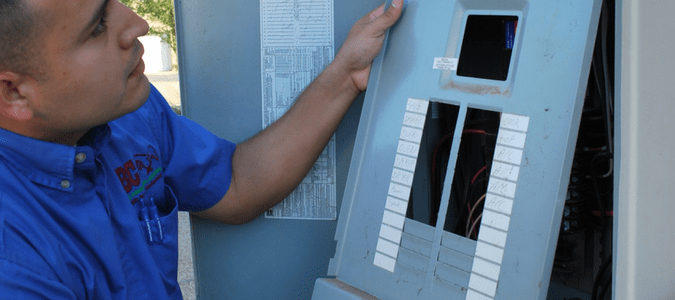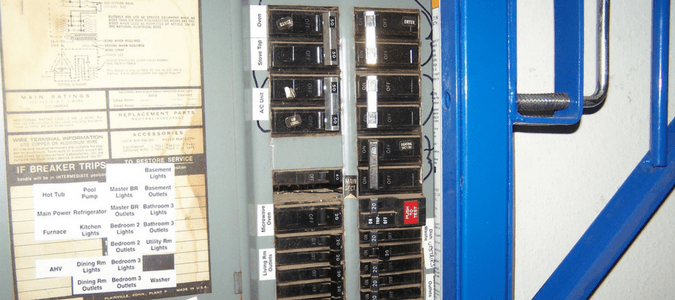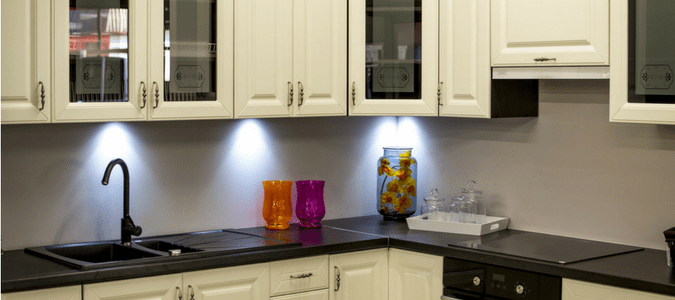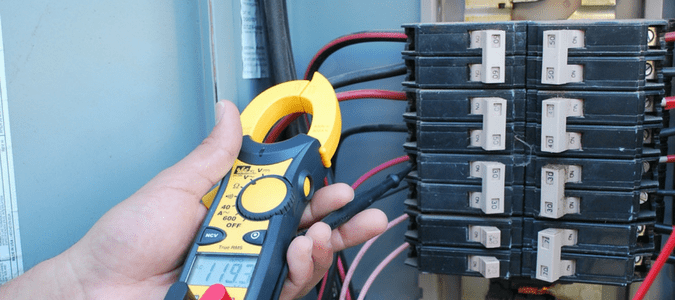
Owning a home has many benefits. Unfortunately, one of the disadvantages is that things break. Sometimes, you have no clue why something isn’t working. Diagnosing the problem is only half the battle. When it comes to electrical issues, most homeowners have little idea what exactly the problem is, much less how to fix it.
If you’ve had trouble with electricity or appliances working properly, this post will shed some light on if you need to upgrade your electrical panel, how to determine your panel’s capacity and why hiring an electrician is the best way to go if you are thinking about how you can change your electrical panel yourself.
What Is a Breaker Panel?
Before we discuss how and why your electrical panel might not be working, let’s talk about the breaker panel itself. An electrical panel is the central point that connects the wires from outside to the wires inside your home and how your electric service provider provides electricity to your home. It’s often also called the main breaker box, the fuse box, a distribution panel, a load center and even a breaker panel. This is where you go when you need to flip the breakers off and on to get the power back on when you’ve tripped the breaker. It is usually located in the garage, on your home’s exterior or in a utility room, but can be anywhere in your home.
There are a few different types of panels: main breaker panels, main lug panels and transfer switches.
Main Breaker Panels
These panels have a main built-in breaker that can shut off all the power to your property. This double-pole circuit breaker both identifies the capacity of your panel’s circuits and protects those circuits from becoming overloaded.
Main Lug Panels
Instead of having a main breaker, line wires go to lugs in these types of panels. Main lug panels have a separate shut-off system, which could be near the meter or connected to the main panel’s breaker. Having a disconnect near your meter allows firefighters to cut your power without needing to enter your living structure.
Transfer Switches
If you need more than one circuit in a particular area, such as in a greenhouse or a workshop, you may want a sub-panel. Sub-panels typically don’t have their own disconnect and are generally powered from the main panel.
A particular type of sub-panel that is used to transmit portable generator power is a transfer switch. Transfer switches are often recommended in areas with frequent storms, where alternate power sources can be needed on occasion. This setup allows a homeowner to easily switch to a backup power source when the regular source of electricity is unavailable. Manual transfer switches are less costly, but require you to manually switch the power load to your backup system, while automatic transfer switches provide a homeowner with more reliable protection.
The main types of circuit breakers are single pole, double pole, arc fault circuit interrupters (AFCO) and ground fault circuit interrupters (GFCI). You can choose between full size, half size and twin or tandem single pole breakers, which provide 120 volts of electricity. Hot water heaters and appliances tend to have double pole circuit breakers, which provide 240 volts of power. AFCIs turn off power to an area when worn or damaged wires are present. These typically are installed in common areas and bedrooms. An electrician will recommend that kitchens, bathrooms and garages have GFCIs, which protects homeowners from electrocution around wet areas.
Most of the time, you don’t think much about your breaker panel. However, like other equipment in your home, electrical panels sometimes need to replaced or upgraded. There are a variety of reasons for this.
Should I Upgrade My Electrical Panel?
Circuit breaker panels typically last 25 to 40 years. There are other questions to ask when determining if you need to upgrade or replace your electrical panel, such as:
Does your home still have a fuse box?
If your home still relies on an old-fashioned panel with fuses, which is common in homes built prior to 1960, then you probably want to upgrade to an electrical panel with circuit breakers. Fuses burn out and need to be replaced and circuit breakers just need to be reset with a flip of the switch.
Is your home more than 20 years old?
If your home is more than 20 or 30 years old, you may need an upgrade. Older homes typically have panels that top out at 60 or 100 amps. Newer homes usually have 200-amp panels which fit our lifestyles. Today’s electricity needs are greater than before with high-definition televisions, computers, smart refrigerators and other appliances.

Is your electrical panel warm?
If the panel feels warm to the touch, it could be a sign that the panel is overloaded, improperly installed or defective.
Does your electrical panel smell?
If the panel gives off a burning smell, this could be a sign that either there is a bad circuit breaker or that a wire isn’t properly connected. Either one of those warning signs can put you at risk for an electrical fire.
Does your electrical panel trip often?
If your electrical panel trips often or if it makes a crackling sound, it may need to be replaced. The system will trip when you plug too many appliances into a circuit which requires more power than the circuit can accommodate. The “tripping” or cutting off power is a safety measure to prevent the wires from overheating. This may mean that just the breaker needs to be replaced and not the whole panel.
Do your appliances run at full capacity?
If your appliances aren’t running at full capacity, it may be a result of a faulty electrical panel. The circuits could be overloaded. If that’s not the problem, it may be that the panel is outdated and you need more electricity to handle the current load that your home requires.
Do your lights dim or flicker frequently?
If your lights dim or flicker frequently, especially when you use other appliances, this could be a sign of connection coming loose or something failing.
Are you upgrading your appliances or adding on to your home?
If you are considering a major new appliance upgrade or addition to your home that would require additional amps, you might consider an upgrade.
Do you find yourself using a lot of power strips?
If you need additional wall outlets throughout your home, you may consider upgrading the panel to supply the power you will need to run everything.

Do I Need To Upgrade My Electrical Panel?
To learn about the capacity of your current breaker panel, look on the inside. There will be a tag, usually, on the door, that will list maximum voltage, current and power dissipation capability for the panel and busses. Most breaker boxes are 100, 150 or 200 amps. The average home typically requires 200 amp panels to fully operate all of your appliances and meet your electrical needs.
If you answered yes to our questions above, or find that your current panel doesn’t meet modern home electricity requirements, you may decide it’s time for an upgrade.
How To Upgrade Electrical Panel: Should You Do It Yourself?
Depending on local and state laws, some homeowners can pull a permit and do this project themselves. In a vast majority of cases, you’ll want to call an electrician to perform this potentially dangerous and involved project. In fact, many cities require a licensed master electrician to perform this type of work.
What are a few reasons you should leave this job to a pro? Remember that when you work on an outlet, you can disconnect the electricity to that area. However, that isn’t the case with the electrical panel. Even when you shut off the main breaker, the lugs still carry live electricity. The two top lugs of the meter are where the power lines connect, which means there is high voltage at a lethal level coming into the service panel. If you come into contact with it, either directly or indirectly, you can be seriously injured or even killed.

Even if you were to upgrade your electrical panel on your own, that in and of itself won’t increase the power supply to your home. An experienced electrician will tell you that in addition to a new breaker box, you’ll also need to install new cables and an electrical meter. You’ll also want to rely on an expert to tell you more about the local codes to make sure your upgrade is compliant with the latest regulations.
The main parts of your breaker panel are the main breaker, your circuit breakers and what’s called bus bars. What does each do?
Main Breaker
This large circuit breaker protects your circuit breakers from becoming overburdened by limiting the amount of electricity which feeds into each breaker. The main breaker also pinpoints the amperage limits of your breaker panel.
Circuit Breakers
Many homeowners are familiar with these parts, which are what “trips” when there is a power surge to a certain part of your home. Each breaker has an on/off switch that adjusts the amount of electricity going to each circuit.
Bus Bars
These components bring power from your electrical meter through two black, thick wires to your individual circuits.
Neutral Bus Bars
Your neutral bar connects to the neutral wire of the main circuit and brings electricity back to your panel after delivering needed power to all the parts of your home. In some areas, your neutral bar is connected to the main grounding wire.
Grounding Bus Bars
All the grounding wires come together at the ground bar, which also connects to the grounding conductor, which goes underground.
Upgrade Electrical Panel DIY Risks
Electrical projects are not the best for do-it-yourselfers. There are many things that can go wrong, some of which are fatal. Hiring a licensed, experienced electrician will most likely save you in the long run. These professionals are aware of the local and most recent electrical codes and can inspect your electrical panel and wiring for any defects.
Electricians go through extensive training to become licensed and are required to complete continuing education hours to renew their licenses, which also keeps them up with national, state and local laws and regulations.
According to the National Fire Protection Association, “Between 2010 and 2014, U.S. municipal fire departments responded to an average of 45,210 home structure fires involving electrical failure or malfunction. These fires caused annual averages of 420 civilian deaths, 1,370 civilian injuries, and $1.4 billion in direct property damage.”
An electrician also does more than just safely wire your home; he or she can expertly advise you on how much electricity your home actually needs to run properly. Be sure to tell him or her about any future big appliance upgrades or additions you have planned. Even a new TV and installing surround sound or other devices can make a difference in the amount of electricity your home needs. An electrician can also tell if your wiring is old or if circuits are damaged.
When looking for an electrician, make sure you get several quotes and remember that the cheapest option is not always the best. You want to select a trained and licensed electrician with references. The average electrical panel upgrade takes about 8 to 10 hours to complete. While the cost may be more than what you might spend having a ceiling fan installed or a new light switch put in, upgrading your electrical panel will prevent future problems and ensure your home can handle all its electrical needs.
If you have any questions about whether your electrical panel or wiring will pass inspection, you can check the National Electric Code or your local licensing or inspecting authority.
Leave Electrical Work To The Pros
While you can do electrical work on your own, it may not be a good idea. When dealing with electricity, there are many things that can go wrong. You also want to ensure that everything is up to code and working properly so you don’t have an electrical fire. The experienced, insured and licensed electricians at ABC Home & Commercial Services can help you with your electrical panel upgrades as well as any other electrical needs you may encounter during the upgrade. Schedule an electrical service today.

